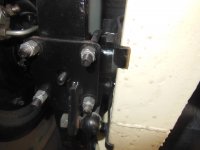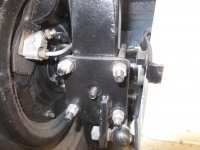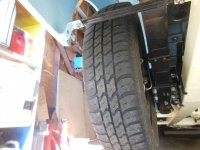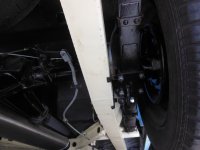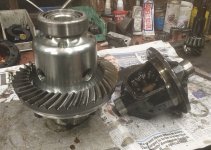Steve
How severe is the pull? Do you feel the steering wheel wanting to rotate clockwise does it seem that the whole car is just changing attitude so that you need to apply counterclockwise force? Is it happening on acceleration too? Look at the Moss diagram of the rear end. A stock rear differential carrier will look like part 10 of the diagram (the carrier). Parts 11 (axle gears), 13 (pinion gears, not to be confused with drive pinion in part set 18), 15 (pinion gear shaft) and 17 (axle spacer) will all be readily visible when you look thru the opening of the carrier. John's suspects are one or more of parts 11 and 13. You would be able to see damage to parts 11 or 13 The axle gears slip into the holes on the side of the carrier and spin freely in the carrier when the axles are out. Pinion gears also spin freely around the pinion shaft when the axles are out. If you imagine the axle gears, pinion gears and pinion shaft installed in the carrier with the axles out, spinning one axle gear would spin the pinion gears, which in turn would spin the other axle gear opposite to the way you are turning the first one. This mechanism allows the rear wheels to spin at different speeds when they are going around a corner. In a corner, the inside wheel travels a shorter distance than the outside wheel. If you have a home made locked differential, there would be visible welds holding the axle gears to the carrier. In a turn with such a set up, both wheels turn at the same speed, so one of the tires has to slip on the pavement. A positraction or limited slip system would look nothing like an open carrier, would probably be a closed cylinder and you couldn't see the inside. Such a unit essentially has the axle gears connected by clutches, so they both want to spin at the same speed as the carrier and as each other, but when the wheels' desire to spin at different speeds hits a certain threshold, the clutches allow them to do so.
Multiple leaf springs are held together only by the locating bolt that the penetrates the axle pad and the bolts that hold the axle to the springs. The leaves are supposed to move against each other when the spring flexes. As John said, there is nothing remarkable in your springs as pictured. For a better understanding of what an open diff does, google "diagram of how an open differential works" and take your pick of info.
Bob

 Hi Guest!
Hi Guest!

 smilie in place of the real @
smilie in place of the real @
 Pretty Please - add it to our Events forum(s) and add to the calendar! >>
Pretty Please - add it to our Events forum(s) and add to the calendar! >> 

